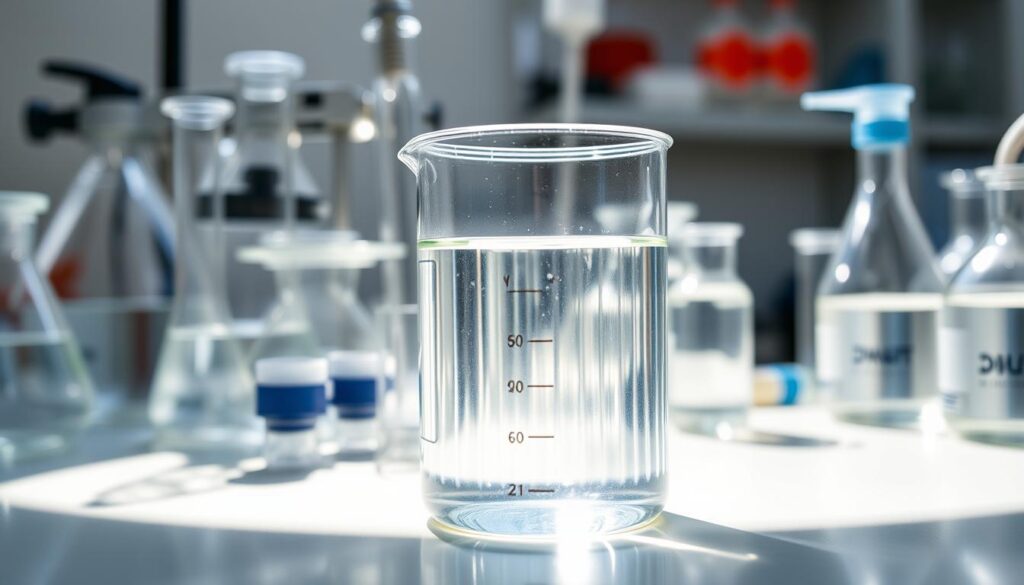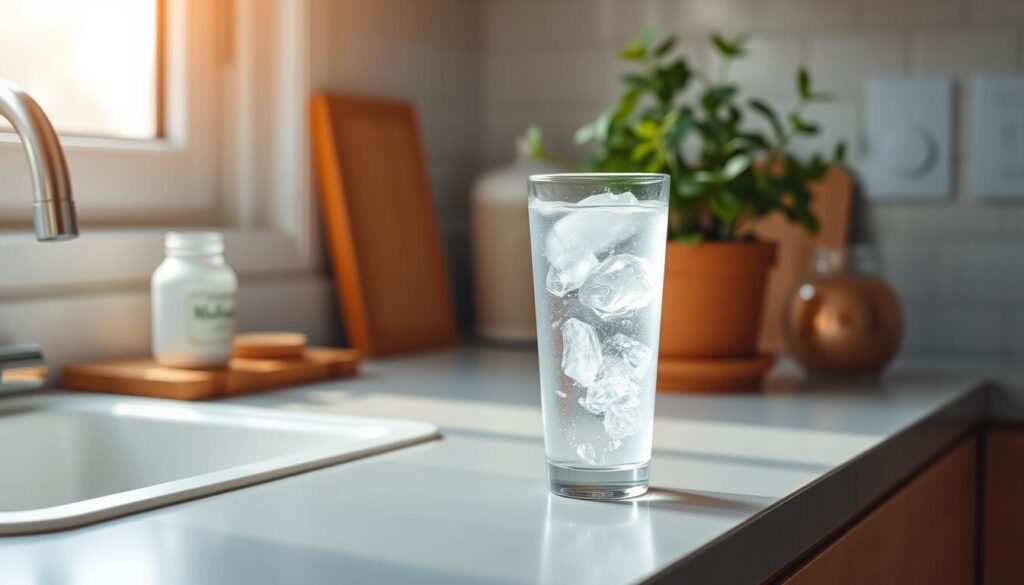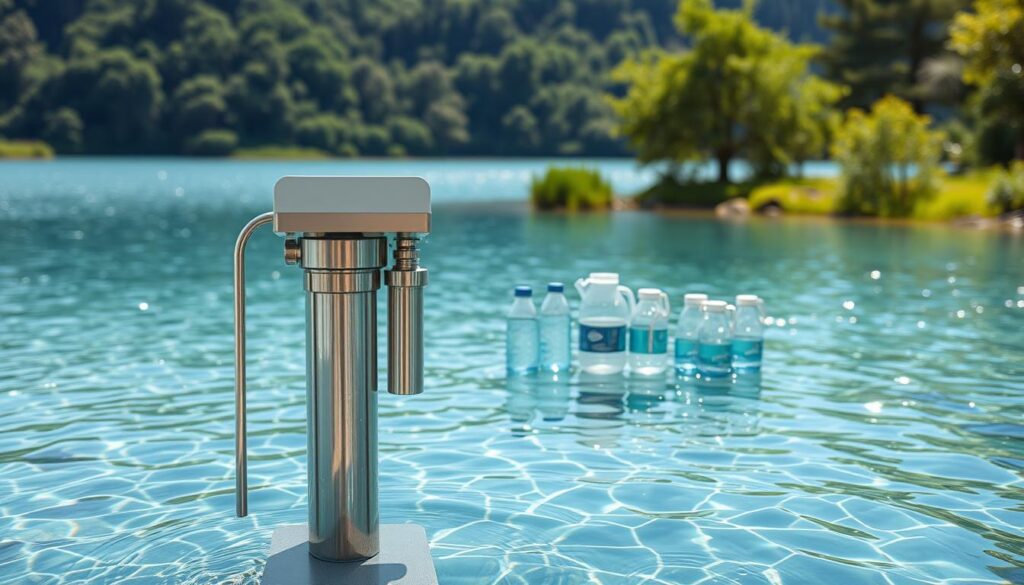If you worry about the safety of your home’s drinking water, a detailed water analysis can ease your mind or show you problems.
I’ve explored the world of water quality testing and seen its importance for health and the environment. This guide will help you understand the process and why regular testing is key.
By following this guide, you’ll learn to spot and fix problems. This ensures a safer, healthier place for you and your family.
Key Takeaways
- Understand the importance of regular water analysis for health and environmental concerns.
- Learn how to identify possible issues with your home’s water supply.
- Discover the steps to take corrective actions and ensure a safer environment.
- Gain insights into the complete guide to effective water quality testing.
- Recognize the role of water quality testing in keeping your home healthy.
Understanding the Importance of Water Quality Testing
Water quality testing is very important for our health and the environment. It helps find harmful substances in water. This makes sure the water is safe to drink and use for other things.
Testing water regularly has many benefits. It finds problems early, which helps stop diseases. This way, we can fix issues before they get worse.
Benefits of Regular Testing
Testing water often keeps our water healthy. Here are some main benefits:
- Early Detection of Contaminants: Testing early catches problems before they get bad.
- Protection of Public Health: Safe water means we stay healthy and avoid diseases.
- Environmental Protection: Testing keeps water clean for animals and plants too.
Health Risks of Poor Water Quality
Poor water quality is bad for people and animals. It can cause many health problems. Some of these include:
- Waterborne Diseases: Diseases like cholera and typhoid come from bad water.
- Chemical Poisoning: Some chemicals in water can poison us and harm our health long-term.
Environmental Impact
Poor water quality also hurts the environment. It can damage the health of rivers and lakes. This affects animals and plants.
The EPA says to use a certified lab for water tests. This is key for keeping our water and environment safe.
Knowing why water quality testing is important helps us keep our water safe. We can make sure our water is healthy for everyone.
Common Contaminants Found in Water
It’s key to know what can be in our water for good water quality assessment. Looking into what affects drinking water quality shows finding common contaminants is vital.
Water can have many harmful things in it. These can hurt our health and the planet. The usual culprits are heavy metals, bacteria, viruses, and chemicals.
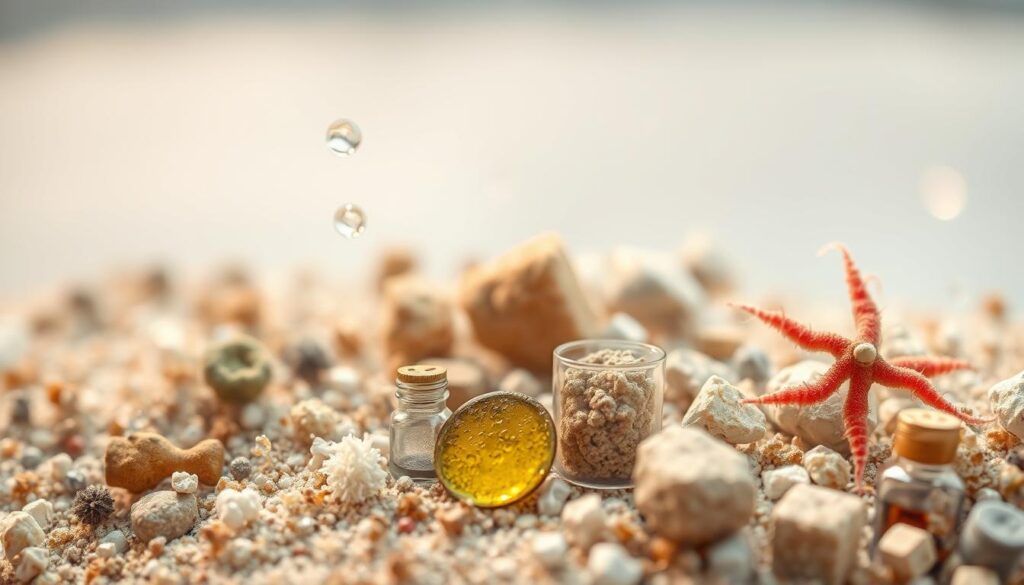
Heavy Metals
Heavy metals like lead, mercury, and arsenic can get into our water. They come from old factories, old pipes, or the earth itself. Being exposed to them can cause big health problems, like brain damage and failing organs. For kids, lead is very bad because it can mess with their brains.
Bacteria and Viruses
Bacteria and viruses are big worries for drinking water quality. Germs like E. coli and Salmonella can make us very sick. Viruses, like norovirus and rotavirus, can also make people sick, leading to outbreaks.
Chemical Pollutants
Chemicals from factories and pesticides can also get into our water. They come from farms or when factories dump waste. These can cause long-term health problems, like cancer and trouble making babies. It’s important to check for these in our water quality assessment.
In short, finding heavy metals, bacteria, viruses, and chemicals in water shows we need to test it often. Knowing what to look for helps keep our water safe for everyone.
Types of Water Quality Tests
Effective water quality monitoring involves a range of tests. These tests can be broadly classified into three main categories. They are designed to detect different types of contaminants and assess the overall quality of water.
Physical Tests
Physical tests measure the physical characteristics of water. This includes temperature, turbidity, and total suspended solids. These tests are key for determining the aesthetic quality of water.
They can also indicate the presence of certain contaminants. For example, high turbidity suggests the presence of suspended particles or microbial contaminants.
Chemical Tests
Chemical tests analyze the chemical composition of water. They detect substances like heavy metals, pesticides, and industrial pollutants. These tests are vital for identifying health risks associated with chemical contaminants in water.
Finding safe drinking water often involves conducting these tests. It ensures the water is free from harmful chemicals.
Biological Tests
Biological tests examine the presence of microorganisms in water. This includes bacteria, viruses, and algae. These tests are critical for assessing the risk of waterborne diseases.
Biological contaminants can pose significant health risks. Their detection is essential for ensuring the safety of drinking water.
| Test Type | Purpose | Examples of Contaminants Detected |
|---|---|---|
| Physical Tests | Measure physical characteristics | Turbidity, Total Suspended Solids |
| Chemical Tests | Analyze chemical composition | Heavy metals, Pesticides, Industrial pollutants |
| Biological Tests | Examine presence of microorganisms | Bacteria, Viruses, Algae |
By employing these different types of water quality tests, individuals and organizations can comprehensively assess water quality. They can take necessary steps to mitigate any identified risks. Regular water quality monitoring is essential for maintaining safe and healthy water supplies.
Equipment for Water Quality Testing
To get reliable results, picking the right equipment for water quality testing is key. The equipment you choose depends on the contaminants you want to test for and how accurate you need the results. Knowing the different types of equipment is important for a good water quality check.
Basic Testing Kits
Basic testing kits are a good start for checking water quality. They usually have test strips or simple chemical tests for common contaminants like lead, nitrates, or bacteria. They are easy to use, not too expensive, and give quick results. But, they might not be as precise as more advanced methods and can’t find all types of contaminants.
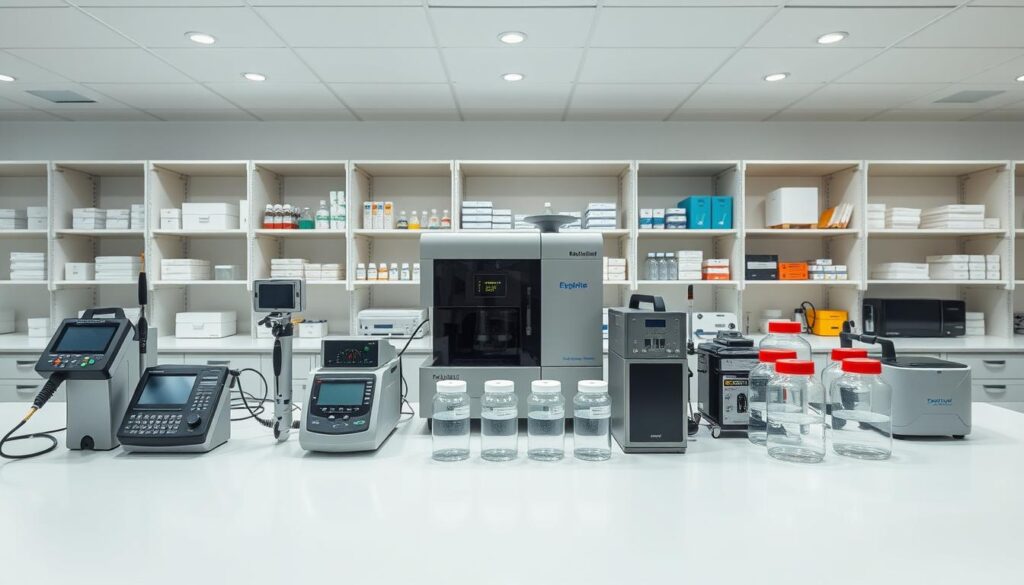
Advanced Laboratory Equipment
For a deeper analysis, you need advanced lab equipment. This includes spectrophotometers, chromatography systems, and microbiological analyzers. These tools are very precise and can find many contaminants, from heavy metals to complex organic compounds. They give detailed and accurate results but are pricier and need special training to use.
Choosing the Right Equipment
When picking equipment for water quality testing, think about a few things. The table below helps you make a good choice.
| Equipment Type | Accuracy Level | Cost | Complexity |
|---|---|---|---|
| Basic Testing Kits | Moderate | Low | Simple |
| Advanced Laboratory Equipment | High | High | Complex |
The right equipment depends on the water quality standards you’re testing against and how detailed you need your analysis. By knowing what each equipment can do, you can choose what fits your needs best.
How to Collect Water Samples Correctly
Collecting water samples right is key to getting accurate water quality tests. It’s all about following a few important steps. These steps help make sure the results from a water testing lab are trustworthy.
Preparing for Sample Collection
Before you start, get your gear ready and know how to collect samples. You’ll need the right containers and a clear plan. Also, make sure you know what tests you’re doing.
Key steps in preparation include:
- Choosing containers that are right for your water sample and tests.
- Keeping all your equipment clean and sterile to avoid contamination.
- Looking over your sampling plan and knowing the protocol.
Proper Sampling Techniques
Getting water samples right is essential for accurate results. You need to know how to use your equipment and collect samples without messing them up. Also, you must record all the important details about the sample.
Some best practices for sampling include:
- Getting samples from the right depth and spot.
- Using separate gear for each sample to avoid contamination.
- Labeling samples with the right info like date, time, and where you got it.
Preserving Water Samples
Keeping water samples in good condition is critical for accurate test results. This might mean storing them at a certain temperature, using preservatives, or testing them quickly.
Preservation methods include:
- Cooling samples to slow down any biological changes.
- Using chemical preservatives to keep the sample from degrading.
- Testing the samples within the suggested time frame.
Interpreting Water Quality Test Results
After you’ve tested your water, it’s time to understand the results. Knowing what the data shows is key to spotting any water issues.
Water test results can vary, depending on the test method. Whether you used a DIY kit or sent a sample to a lab, the goal is to grasp the information.
Reading Test Kits
DIY test kits help you check your water’s pH, chlorine levels, and contaminants. It’s vital to follow the kit’s instructions for accurate results.
Interpreting the results means comparing them to recommended standards. For example, if testing for lead, check if it’s below the EPA’s limit.
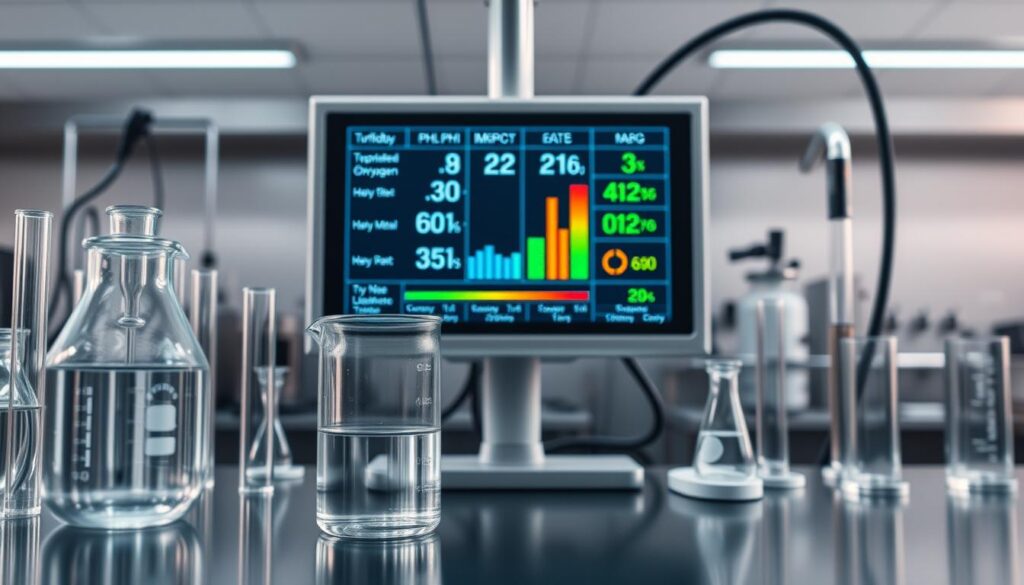
Understanding Laboratory Reports
Laboratory reports offer detailed insights into your water. They check for heavy metals and microbes. When looking at a lab report, focus on:
- The concentration of each contaminant detected
- The maximum allowable levels as per regulatory standards
- Any notes or recommendations from the laboratory
Grasping these points is essential for judging your water’s safety and quality.
Comparing Results to Standards
To ensure your water is safe, compare your results to water quality standards. In the U.S., the EPA sets these standards. Check if the contaminant levels are within the allowed limits.
| Contaminant | Detected Level | Maximum Allowable Level |
|---|---|---|
| Lead | 0.015 mg/L | 0.015 mg/L |
| Chlorine | 1.2 mg/L | 4.0 mg/L |
| E. coli | Absent | Absent |
By comparing your results to these standards, you can see if your water is safe to drink.
In conclusion, understanding your water test results is vital. By learning to read test kits, lab reports, and comparing to standards, you can ensure your water is safe.
Tips for Effective Home Water Quality Testing
Keeping your water quality good is more than just testing it sometimes. To make sure your drinking water is safe and healthy, you need a full plan. This includes regular testing, keeping things in good shape, and being ready for surprises.
Frequency of Testing
Testing your water often is key to good water quality at home. I suggest testing it at least once a year for things like bacteria, nitrates, and heavy metals. But, if you have a well or live in a place where water quality can be bad, you might need to test more often.
- Test for bacteria, viruses, and nitrates annually.
- Check for heavy metals like lead and mercury every 2-3 years.
- Test more often if you notice changes in taste, odor, or appearance.
Routine Maintenance
Keeping your water treatment systems in good shape is important. This means checking and changing filters, cleaning equipment, and looking for signs of damage in your pipes.
Key maintenance tasks include:
- Changing water filters as the maker says.
- Looking over your plumbing for leaks or damage.
- Cleaning water tanks and treatment gear.
Preparing for Unexpected Issues
Even with the best plans, unexpected water problems can happen. Being ready means having a plan for emergencies, like a backup water source or a portable testing kit.
Here are steps to get ready for unexpected problems:
- Have a backup water supply, like bottled water, ready.
- Get a portable water testing kit for quick checks.
- Stay up to date on local water quality news and alerts.
Testing Water from Different Sources
Different water sources need different testing methods for accurate results. The source of the water is key in deciding what tests are needed.
Municipal Water
Municipal water is treated and managed by local utilities. It’s usually safe, but regular tests are needed to meet water quality standards. I suggest testing for chlorine levels, pH, and turbidity.
Well Water
Well water isn’t treated by a municipal utility. So, regular testing is vital for safety. I recommend checking for bacteria, nitrates, and heavy metals, as they can be harmful.
Surface Water
Surface water, like rivers and lakes, needs testing for pH, turbidity, and biological contaminants. It can get contaminated from the environment, so monitoring is key.
Here’s a comparison of testing needs for different water sources:
| Water Source | Recommended Tests | Frequency |
|---|---|---|
| Municipal Water | Chlorine levels, pH, turbidity | Quarterly |
| Well Water | Bacteria, nitrates, heavy metals | Bi-annually |
| Surface Water | pH, turbidity, biological contaminants | Monthly |
The table shows that testing types and frequencies change based on the water source. Knowing these differences is essential for effective water quality monitoring.
What to Do If Your Water Quality Is Poor
If your water quality is bad, you need to act fast. It’s important to know what’s wrong and how to fix it. This helps avoid health problems.
Remediation Options
There are many ways to fix poor water quality. You can get water filters, use purification tablets, or boil water. The best method depends on the test results.
Common Remediation Techniques:
- Activated carbon filtration
- Reverse osmosis
- UV treatment
- Boiling
Talking to a water testing laboratory is key. They can help find the best fix for your water problems.
Contacting Local Authorities
If your water is bad, tell local authorities. They can help figure out what’s wrong and fix it.
Health departments or environmental agencies are good places to start. They can give advice and help improve your water.
Long-Term Solutions
Fixing water quality for good means finding and fixing the source. Regular tests and prevention are important.
Following water quality standards is essential. Keeping water systems in good shape helps keep water clean.
| Long-Term Solution | Description | Benefits |
|---|---|---|
| Regular Water Testing | Frequent testing to monitor water quality | Early detection of problems |
| Infrastructure Maintenance | Regular upkeep of water supply systems | Keeps water quality high |
| Water Filtration Systems | Installation of filtration systems to remove contaminants | Better water quality and safety |
Staying Informed About Water Quality Issues
It’s important to stay informed about water quality. Regular water quality testing helps find and fix problems. To keep your water safe, learn about the latest in water testing.
Resources for Further Education
Many resources can help you learn about water quality testing. The Environmental Protection Agency (EPA) has great info on their website. They offer guidelines for testing and keeping water clean. Check out these resources to learn more.
Community Engagement
Getting involved in your community is also key. Many groups work to improve local water quality. Joining these efforts helps you stay informed and helps your community.
Regulatory Updates
Staying current with regulations is vital. Changes in rules can affect water testing and maintenance. Keep an eye on updates from local authorities and regulatory bodies. This ensures you follow the latest water quality standards.
FAQ
What is the importance of water quality testing?
Testing water quality is key to spotting health and environmental dangers. It makes sure the water is safe to drink and use for other things.
How often should I test my drinking water quality?
Testing frequency varies by water source. Well water needs more tests than city water. Test at least once a year or as local laws say.
What are the common contaminants found in water?
Common pollutants include heavy metals like lead and mercury. Also, bacteria and viruses like E. coli and rotavirus. Chemicals like pesticides and industrial waste are also found.
What types of water quality tests are available?
There are physical, chemical, and biological tests. Each type finds different contaminants and checks water quality in different ways.
How do I choose the right equipment for water quality testing?
Equipment choice depends on the test type, needed accuracy, and where you test. Options range from simple kits to complex lab gear.
How do I collect a water sample correctly?
To get a good sample, prepare your gear, follow sampling steps, and keep the sample safe. This ensures your tests are accurate.
How do I interpret water quality test results?
Understanding results means knowing what the tests show. Compare them to quality standards. Then, act on the findings.
What should I do if my water quality test results are poor?
If results are bad, look into fixing the problem. Talk to local authorities for advice. Find long-term solutions, possibly with lab help.
How can I stay informed about water quality issues?
Stay informed by learning more, joining local discussions, and following water quality news and rules.
What is the role of certified laboratories in water quality testing?
Labs give accurate test results. They help people and communities understand their water. This leads to better decisions.
How does water quality testing impact environmental water testing?
Testing is key for environmental checks. It spots issues and helps protect water resources.

